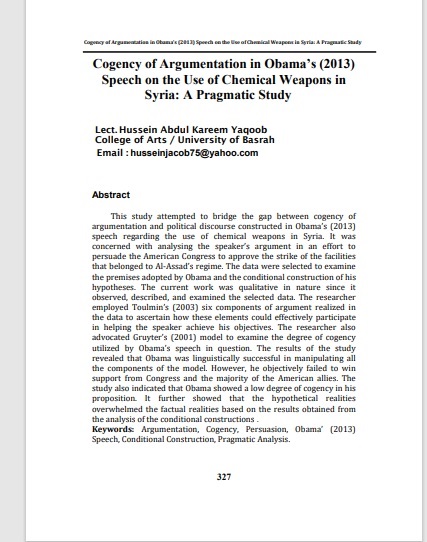قوة الحجاج في خطاب أوباما (2013) بعد استخدام الأسلحة الكيميائية في سوريا دراسة تداولية
محتوى المقالة الرئيسي
الملخص
تسلط هذه الدراسة الضوء على العلاقة بين قوة الحجاج، ذات المنظور التداولي، وبين الخطاب السياسي بالإشارة الى خطاب أوباما عام 2013 بشأن استخدام الأسلحة الكيميائية في سوريا. وتعنى الدراسة هذه بتحليل هذا الخطاب الذي حاول فيه المتحدث اقناع الكونغرس الأمريكي بالموافقة على ضرب نظام الأسد بعد استخدام أسلحة محرمة دوليا ضد السوريين في محاولة هدفت الى تحليل الفرضيات التي تبناها أوباما، وكذلك تحليل التراكيب الشرطية لفرضياته. والدراسة الحالية ذات طبيعة نوعية كونها تراقب وتصف وتتفحص الخطاب المعني. تبنى الباحث مفردات الحجاج الستة لتولمن (2003) سعيا لمعرفة كيف تم توظيف هذه المفردات في الخطاب. كما تبنى ايضا مفهوم اخر لجروتر (2001) لتحديد قوة الحجة التي استخدمها أوباما في خطابه تداوليا. وقد كشفت نتائج الدراسة أن الرئيس الأمريكي السابق نجح في توظيف جميع مكونات الحجاج الستة في الخطاب المعني من الناحية اللغوية، لكنه لم ينجح موضوعيا في الحصول على موافقة الكونغرس وأغلبية الحلفاء الأمريكيين. وكشفت الدراسة أيضًا أن أوباما كان غير مقنع في حجته حيث أن الحقائق الافتراضية طغت على الحقائق الواقعية وذلك حسب نتائج تحليل التراكيب الشرطية في خطابه.
تفاصيل المقالة

هذا العمل مرخص بموجب Creative Commons Attribution-ShareAlike 4.0 International License.
المراجع
Admoko, S., Suprapto, N., Deta, U. A., Achmadi, H. R., & Hariyono, E. (2021, March). Using Toulmin’s Argument Pattern Approach to Identify Infodemics in the Covid-19 Pandemic Era. In Journal of Physics: Conference Series (Vol. 1805, No. 1, p. 012011). IOP Publishing.
Al-Juwaid, W. R. H. (2019). the pragmatics of cogent argumentation in British and American political debates. Cambridge Scholars Publishing.
Al-Ka’bi, A. G., (2019). Argumentative indicators in some of Chomsky’s political discourse: A pragma-dialectical study. [Unpublished doctoral dissertation]. University of Basrah.
Ary, D., Jacobs, L. C., Sorensen, C. K., Walker, D. A., & Razavieh, A. (2010). Defining and designing qualitative research. Introduction to Research in Education. https://doi. org/10.1017/CBO9781107415324, 4.
Aschale, A., & Ababa, A. (2013). A critical discourse analysis of Barack Obama’s speeches vis-A-vis Middle East and North Africa. [Unpublished doctoral dissertation]. University of Addis Ababa.
Benoit, W. (2007). Communication in Political Campaigns. New York: Peter Lang Publishing, lnc
Creswell, J. W. (2013). Qualitative inquiry and research design: Choosing among five approaches. (3rd ed.). Sage publications.
Eemeren, F, H., and Grootendorst, R. (2004). A systematic theory of argumentation: The pragma-dialectical approach. Cambridge University Press.
Faris, A.A. (2021). Trump’s discourse on Iran nuclear deal: A critical
study. Misan Journal of Academic Studies. 20 (40), 48-81.
Fitria Ningsih, O. (2019). An analysis on Barack Obama’s speech viewed from grammatical cohesion [Unpublished doctoral dissertation]. University of Bengkulu.
Freeley, A. J., and Steinberg, D. L. (2013). Argumentation and debate. Cengage Learning. Tashakkori, A., and Teddlie, C. (Eds.). (2010). Sage handbook of mixed methods in social and behavioral research. Sage publications.
Gass, R. H., & Seiter, J. S. (2018). Persuasion: Social influence and compliance gaining. Boston M.A: Pearson Custom.
Gruyter, W. (2000). Language typology and language universals. London: Cambridge University Press.
Hasan, R. (2018). The Myth of the Red Line: An international relations analysis of the Obama administration’s argumentation for and against a military intervention in Syria. [Unpublished master thesis]. University of Lunds.
Indah, R. N., & Khoirunnisa, A. (2018). Argumentative statements in the 2016 presidential debates of the US: A critical discourse analysis. JEELS (Journal of English Education and Linguistics Studies), 4(2), 155-174.
Johnson, R. H. (2000). Manifest Rationality: A Pragmatic Theory of Argument. New Jersey: Lawrence Erlbaum Associates Publishers.
Martinich, A. P. (2016). Authorization and representation in Hobbes’s Leviathan. The Oxford Handbook of Hobbes, 315-38.
Merriam, S. B. (2009). Qualitative research: A guide to design and implementation. San Francisco, CA: Jossey-Bass.
Perloff, R. M. (2003). The Dynamics of Persuasion. Communication and Attitudes in the 21st Century. Mahwah, N.J.: Lawrence Erlbaum Associates.
Pita, R., & Domingo, J. (2014). The use of chemical weapons in the Syrian conflict. Toxics, 2(3), 391-402.
Poggi, I. (2005). The goals of persuasion. Pragmatics & Cognition, 13(2), 297-335.
Quasthoff, U. (1978). The uses of stereotype in everyday argument. Journal of pragmatics, 2(1), 1-48.
Telhami, S. (2013). Arab Perspectives on Iran's Role in a Changing Middle East. Wilson Center.
Toulmin, S. E. (2003). The uses of argument. Cambridge: CUP
van Eemeren, F.H. (2015). Reasonableness and Effectiveness in Argumentative Discourse. Amsterdam: Springer International Publishing
Virtanen, T., & Halmari, H. (2005). Persuasion across genres: Emerging perspectives. In Halmari, H. & Virtanen, T. (Eds.), Persuasion Across Genres: A Linguistic Approach (3–24). Amsterdam: John Benjamins Publishing Co
Voloshchuk, I., & Usyk, G. (2018). Argumentation in Political Discourse: Semantic, Composition and Stylistic Register. Humanities and Social Sciences Review, CD-ROM. ISSN, 2165-6258.
Wrobel, S. (2015). Logos, Ethos, Pathos. Classical Rhetoric Revisited. Polish Sociological Review, 191(3), 401-421.
Websites
https://www.bbc.com/news/world-middle-east-45586903
https://edition.cnn.com/2017/04/07/politics/obama-syria-airstrikes-trump/index.html
